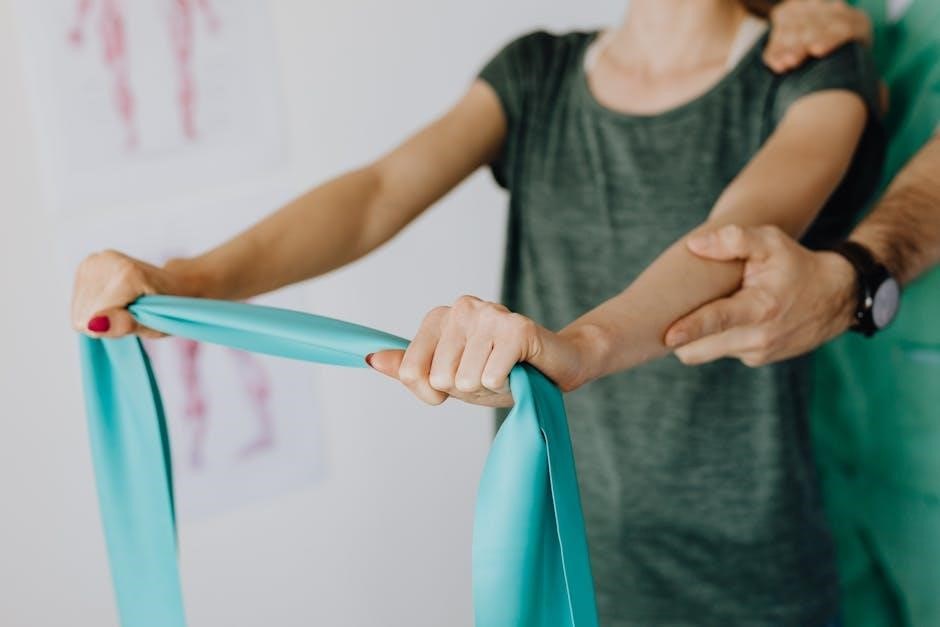Shoulder dislocation rehabilitation protocol pdf guides patients through recovery with exercises and physical therapy to regain strength and mobility in the affected shoulder joint and surrounding muscles and tissues slowly.
Importance of Rehabilitation Guideline
The rehabilitation guideline is crucial for individuals who have experienced shoulder dislocation‚ as it provides a structured approach to recovery. A well-designed protocol helps patients regain strength‚ mobility‚ and function in the affected shoulder joint and surrounding muscles. The guideline outlines specific exercises‚ physical therapy‚ and interventions to promote healing and prevent further injury. By following a rehabilitation guideline‚ patients can reduce their risk of future dislocations and improve their overall quality of life. The protocol also helps clinicians and healthcare professionals provide consistent and effective care‚ ensuring that patients receive the best possible treatment. Additionally‚ the guideline takes into account individual factors‚ such as the severity of the dislocation and the patient’s overall health‚ to create a personalized rehabilitation plan. This tailored approach enables patients to progress at their own pace and achieve optimal outcomes. Overall‚ the rehabilitation guideline plays a vital role in the recovery process‚ enabling patients to return to their normal activities and maintain long-term shoulder health. Effective rehabilitation is essential for preventing chronic shoulder instability and related complications.

Rehabilitation Protocol for Non-Operative Shoulder Dislocation
Non-operative shoulder dislocation rehabilitation involves physical therapy and exercises to promote healing and restore function slowly and carefully always.
Exercises for Shoulder Rehabilitation

Exercises for shoulder rehabilitation are a crucial part of the recovery process‚ helping to restore strength‚ flexibility‚ and range of motion to the affected shoulder joint and surrounding muscles.
The exercises typically include a combination of movements that target the shoulder muscles‚ such as the supraspinatus‚ deltoids‚ and rotator cuff.
These exercises may be performed in various positions‚ including standing‚ sitting‚ or lying down‚ and may involve the use of resistance bands‚ light weights‚ or other equipment to provide gentle resistance and challenge the muscles.
The goal of these exercises is to promote healing‚ reduce pain and inflammation‚ and improve overall function and mobility of the shoulder joint.
A physical therapist or healthcare professional can provide guidance and instruction on how to perform these exercises safely and effectively‚ and can help to progress the exercises as the individual’s strength and mobility improve over time.
Regular practice and patience are essential for achieving optimal results and preventing future shoulder problems.
By following a well-structured exercise program‚ individuals can expect to see significant improvements in their shoulder function and overall quality of life.
Exercise programs are often tailored to meet the specific needs and goals of each individual‚ taking into account their age‚ fitness level‚ and any underlying health conditions.

Duration of Rehabilitation
Rehabilitation duration typically lasts several months‚ with most people returning to sport after 12 weeks if non-surgical and 6-months if surgical‚ requiring patience and gradual progression slowly and carefully.
Management of Shoulder Instability
Management of shoulder instability is crucial in the rehabilitation process‚ as it helps to prevent further dislocations and promotes healing. According to the Journal of Orthopaedic and Sports Physical Therapy‚ a comprehensive approach to managing shoulder instability includes a combination of physical therapy‚ exercises‚ and lifestyle modifications. The goal of management is to improve joint stability‚ strengthen surrounding muscles‚ and enhance overall function. A study published in the Journal of Shoulder and Elbow Surgery found that a new method of immobilization after traumatic anterior dislocation of the shoulder can be effective in managing instability. Additionally‚ exercises such as shoulder flexion‚ abduction‚ and rotation can help to improve joint stability and reduce the risk of further dislocations. By following a well-structured management plan‚ individuals with shoulder instability can reduce their symptoms‚ improve their quality of life‚ and return to their normal activities. Effective management of shoulder instability requires a multidisciplinary approach‚ including input from orthopedic specialists‚ physical therapists‚ and other healthcare professionals. With proper management‚ individuals can achieve optimal outcomes and prevent long-term complications. Regular follow-up appointments with healthcare providers are essential to monitor progress and adjust the management plan as needed.

Immobilization After Traumatic Anterior Dislocation
Immobilization for 3-4 weeks helps to reduce pain and promote healing after traumatic anterior dislocation of the shoulder joint slowly and effectively always.
First Time Dislocators Rehabilitation Protocol
For individuals who have experienced their first shoulder dislocation‚ a rehabilitation protocol is crucial to prevent future dislocations and restore shoulder function. The protocol typically involves a period of immobilization‚ followed by a gradual progression of exercises to improve strength‚ flexibility‚ and range of motion. According to various studies‚ first-time dislocators may be immobilized for 3-4 weeks before starting physical therapy. This allows the injured tissues to heal and reduces the risk of further complications. A rehabilitation program for first-time dislocators should be tailored to the individual’s specific needs and goals‚ taking into account factors such as age‚ activity level‚ and overall health. The program should also include education on proper shoulder mechanics and injury prevention strategies to reduce the risk of future dislocations. By following a well-structured rehabilitation protocol‚ first-time dislocators can expect to regain full shoulder function and return to their normal activities within a few months. Regular follow-up appointments with a healthcare professional are essential to monitor progress and make any necessary adjustments to the rehabilitation program. With proper treatment and rehabilitation‚ individuals can reduce their risk of future shoulder dislocations and maintain optimal shoulder health.
Rehabilitation protocols for shoulder dislocation help patients regain strength and mobility slowly and safely always with proper exercises.
Additional Resources
For individuals seeking more information on shoulder dislocation rehabilitation protocol pdf‚ various online resources are available‚ including academic journals and medical websites. The Journal of Orthopaedic and Sports Physical Therapy is a valuable resource‚ providing articles on shoulder instability management and rehabilitation. Additionally‚ the American Academy of Orthopaedic Surgeons website offers a range of educational materials and guidelines for patients and healthcare professionals. Patients can also consult with their physicians or physical therapists to obtain personalized rehabilitation protocols and exercise guidelines. Furthermore‚ online forums and support groups can provide a platform for individuals to share their experiences and connect with others who have undergone similar rehabilitation processes. By exploring these resources‚ individuals can gain a better understanding of the rehabilitation process and make informed decisions about their care. Overall‚ accessing additional resources can facilitate a smoother and more effective recovery from shoulder dislocation. Various websites and publications can be consulted for more detailed information.
